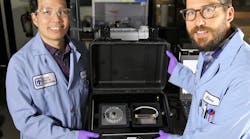Engineers at Sandia National Laboratories have improved their SpinDx mobile diagnostic device so that it can perform both protein and nucleic acid tests. This lets it identify nearly any cause of illness in human patients, including viruses, bacteria, toxins, and immune system markers of chemical agent exposure. The recent addition of a heating element lets the device do nucleic acid tests which search for genetic codes found in any kind of virus, parasite, or bacteria. The machine also detects toxin proteins at the same time and determines whether they are active or not, a critical distinction for correctly tailoring the medical response.
The device’s portability, affordability, rapidity and reliability are critical for addressing infectious disease outbreaks in places most affected by them but least able to afford a laboratory with traditional instruments.
SpinDx looks a bit like a DVD player enclosed in a weather-resistant plastic case. It features a disposable disc that distributes drops of raw, unprocessed biological samples into different channels that function, according to Sandia chemist Chung-Yan Koh, like “dozens of tiny test tubes.”
This automatic distribution step is a great time-saver. “Instead of having to drop processed samples one by one into dozens of tiny chambers, you load one raw sample into a single, central port that evenly distributes your sample into every channel,” explains Chris Phaneuf, a former Sandia bioengineer.
When the disc spins, samples interact with test reagents inside the channels. As Phaneuf puts it: “If there’s a match, they’ll attach.” In other words, if there is a chemical interaction between the sample and reagent, a red laser causes the tip of the channel to glow, signaling an infectious agent to a software interface that displays the result.
Previously SpinDx performed only protein tests, which look for both pathogen-specific proteins and antibodies. Antibodies are proteins manufactured by immune systems in response to infections. When viruses later disappear from the blood, antibodies that flushed them are still detectable. Protein tests also identify lethal toxins such as botulinum neurotoxin, a teaspoon of which could kill around 100 million people, according to Phaneuf.
Thanks to its new heating element and ability to do a new assay, SpinDx can conduct nucleic acid tests and identify the virus or bacteria causing symptoms such as diarrhea. “It’s much quicker to detect the causative pathogen in a sample than to wait for a body to produce antibodies to an infection,” Phaneuf said. “Being able to do both kinds of tests paints the most complete picture of what’s in a person’s system.”
Conventional viral testing (via polymerase chain reaction or PCR) requires heating and cooling a biological sample many times to multiply any viral DNA or RNA to detectable levels. Phaneuf and Koh implemented a new Sandia-developed assay and detection scheme in the SpinDx update. It uses chemistry that only requires a sample to be heated once.
In other diagnostic devices, the loop-mediated isothermal amplification (LAMP) method of heating a sample takes place atop a small heating block that creates a single, uniform temperature inside a device. SpinDx uses a small infrared heat emitter that hovers at the top of the device, targeting only the part of the spinning disc performing the test.
Being able to control the heat flow allows for different temperature zones inside SpinDx, enabling simultaneous nucleic acid and protein tests. Nucleic acid tests require a temperature that would ordinarily destroy a sample’s proteins.
SpinDx has been licensed by industry partners for uses as diverse as testing male fertility testing and monitoring water supply safety. Sandia is also using the technology for research into applications as diverse as bioenergy and chemical warfare detection. In the former case, scientists use SpinDx to search for predators that could destroy algae being cultivated for biofuels and renewable chemicals. In the latter case, Koh tests soldiers for exposure to chemical warfare agents. SpinDx will search for biomarkers of exposure. Temperature control in this research is essential, because it makes the test more precise.
In addition, there is a very short window for treatment should a soldier be exposed to a chemical agent. The speed with which SpinDx delivers results will help ensure treatments are administered in time for them to be effective.
The ability to accurately conduct all these tests at the same time in a portable device and read results in an hour or less sets SpinDx apart from other available devices. Traditionally, such results required a well-equipped lab staffed with experienced technicians.
Koh and Phaneuf say they’d like to see batteries and solar panels added to SpinDx, making it deployable almost anywhere.

